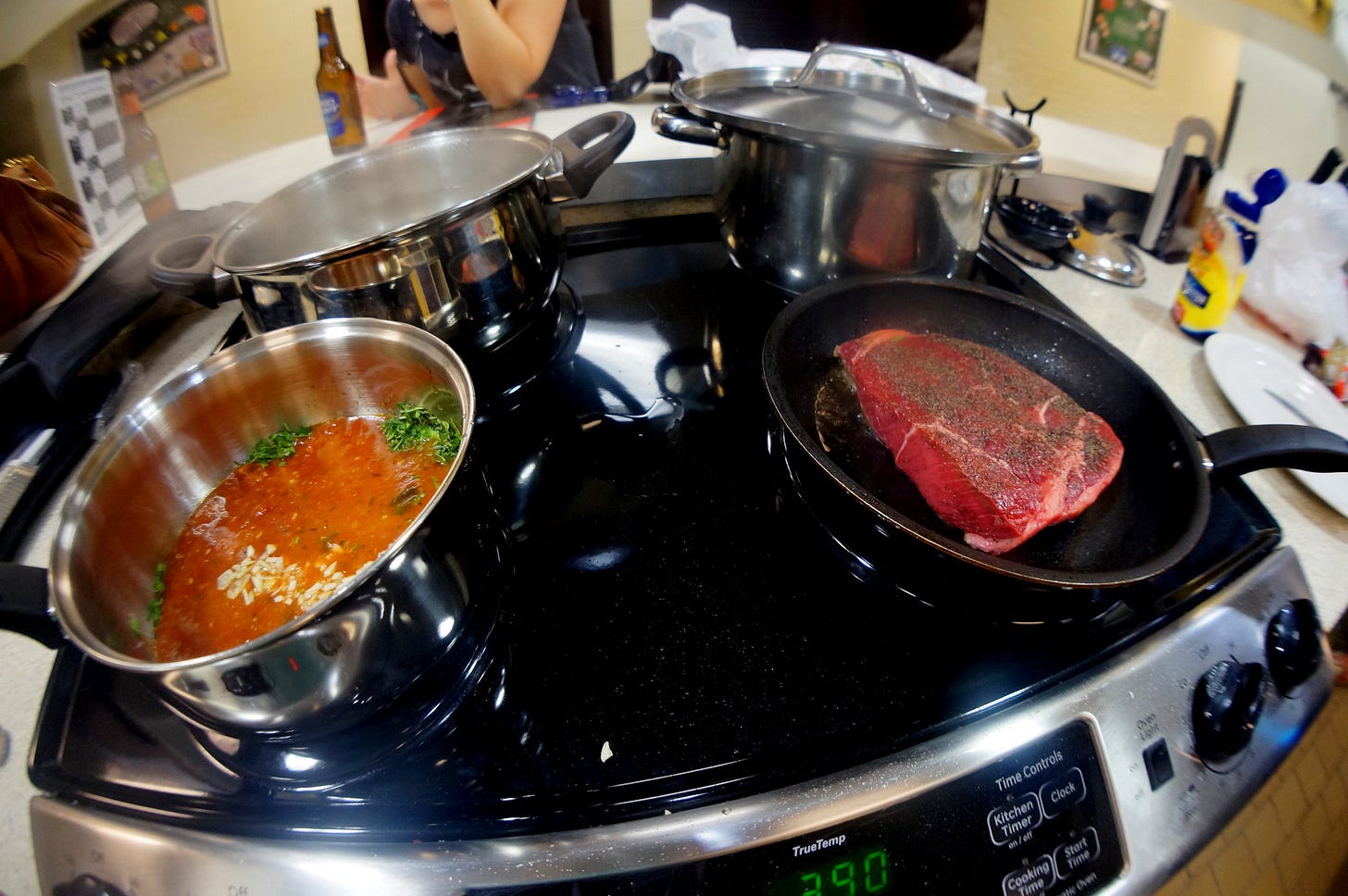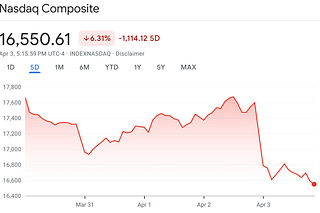
Do Androids Dream of Electric Stoves?
Or how I started worrying and then learned to love my new range and oven.
I regret to admit I was wrong about something: electric stoves are, in fact, usable.
For years—the five years that my wife and I lived in a unit with a gas stove—I had thought I could never use an electric stove again. While we were searching for a house, we considered a gas connection one of our few musts. We barely bothered even looking at all-electric homes. When people said that electric stoves had gotten pretty good, I thought, yeah, yeah, you probably don’t cook much. (I’m talking about conventional electric, not induction, which sound great but cost about twice as much.)
I grew up with a midrange glass-top electric stove that my parents didn’t like—the glass developed all sorts of blemishes, the controls were wonky, the “hot surface” lights broke. After several years they got a new glass-top, and when that too developed blemishes after a couple of uses, they sent it back and got a good, old-fashioned coil electric range. They don’t like it either.
In my grad-school days, my building was outfitted with the cheapest coil stoves you can buy, the ones that look like Soviet appliances with a few curves. The coils would come loose from their sockets, overflowing water would go down into the internals. They were usable, but never fun to use.
Our last place had the first gas stove I’ve ever had. And from the very beginning I thought that was it: Wow, this stove does what you tell it to do. With gas, things heat up fast and cool down fast. The electric stoves I was familiar with take forever to heat up and to cool down; you have to learn to work around the lag times. I never stopped finding it annoying. Electric ovens can also take a very long time to preheat, whereas our gas oven preheated so quickly, I often didn’t even bother preheating—I’d just put the food in, dial the temperature, and start the timer.
So I scoffed when I first started seeing articles about the dangers of gas stoves—indoor air pollution, mostly, but also carbon monoxide (I learned the hard way that you have to crack a window if you run the gas oven all day), and the fact that gas-connected buildings can and do explode. But I’m enough of a skeptic that at first I figured those articles were exaggerating the harms. The messengers and the rhetorical styles made it hard to see the facts underneath. One article said we should be afraid of burning fossil fuels in our living spaces, which suggested a focus not on consumer concerns or health concerns but environmental concerns. “Wait till they learn about home heating oil,” I thought. “Wait till they hear about fireplaces!” (Wood isn’t a fossil fuel, but the EPA’s regulation of wood stoves has been controversial over the years.)
And I guess it also felt like some of the articles warning buyers away from gas ranges and ovens were targeting, and at times sort of mocking, the one gas appliance that’s actually better than its electric counterparts (never mind that the overall push against natural gas will run into a problem in places like the Upper Midwest, where it gets too cold for electric heat pumps to operate efficiently). I suspect some of this is just the way online discourse unfolds. I remember a guy on Twitter saying something along the lines of, “I like saying ‘Ban Cars’ not because I want to ban cars, but because it annoys people I don’t like.” This is closely related to the notion that “When you’re getting flak you’re over the target.” Sure, sometimes—but sometimes you’re just being a jerk.
But back to gas stoves. I did more research, digging into the details in Consumer Reports and various academic-affiliated medical websites, and found that the indoor air pollution issue is real. Among other things, the byproducts of gas combustion can cause or trigger asthma. Good ventilation does solve most of the problem, but it turns out that many houses lack range hoods that vent outside, and very few apartments have them.
One effect that doing this reading had on me: I started to notice that when the stove was on for a length of time, the air smelled kind of like a candle was burning. There was something the stove was putting into the air that was detectable; something I hadn’t noticed before. Over time I grew to not like that.
But anyway. Our new house is all-electric and has a glass-top electric stove. Initially, we were going to put in a propane tank just to change the stove to gas. We even called the homeowner association to make sure that propane tanks were allowed. (They are.) We went to Lowe’s and Home Depot and started to think about which gas stove we wanted.
And then we made dinner for the first time.
On the electric range, the pans heated up quickly. The temperature control was slow, but it was obviously working. The maximum heat was higher than on our gas model, meaning that foods like steaks and Brussels sprouts developed a tasty crisp edge rather than sautéing or steaming.
Each of our first few meals was a test. Eggs? My old gas stove was ready to sizzle eggs in two minutes, and then the eggs cooked in two minutes. My new electric stove needs about three minutes to get up to temperature, and about three minutes to cook the eggs. I could probably shave that down, but I’m wary of dialing it too hot.
Steak? My big test for this stove was whether it could get a cast iron pan nice and hot and put a serious sear on a steak. I use a Lodge skillet, and on my old stove, I heated it up for five minutes on high before throwing in the steak. Generally the steak would get a minute and a half or so per side, maybe two (I sous vide them, so this is just to sear the outside).
Well. After three minutes, my skillet was smoking, and after just one minute per side, my steak was charred in a way that I had never seen on a stove top. It looked—and tasted!—like it had come off a barbecue grill. (Well, off a gas grill, of course—nothing replaces the flavor of charcoal.) I couldn’t quite believe it. Why did I wonder how anybody could find electric stoves usable, let alone use them every day? The proof was on my plate: this thing cooked a better steak than I’d been able to make in five years. I was sold.
But there was one more test: wok stir fries. And here too, the new stove clearly and noticeably outperformed the old one. On my old gas stovetop, vegetables that produce some water, like spinach or cabbage, used to sort of steam, with a pool of water forming in the bottom of the wok that wouldn’t quite disappear. With the new stove, the amount of steam rising out of the wok while I stir fry is so great that I have steam in my face the whole time. The vegetables come out drier and greener, because they’re cooking higher but shorter. It is true that you can’t shoosh the wok on the fragile glass top. But you sure can get distinctively wok-fried dishes on it.
And the oven? It heats faster than the other electric ovens I’ve seen over the years, and the addition of a convection fan also makes it possible to air fry things. (Electric ovens are widely considered superior to gas ovens; I couldn’t tell any difference there.)
I realized as I used this stove that much of what I had always perceived as the inferiority of electric stoves—in addition to not using great ones—was simply trying to force it to do what I wanted and not adapt to it. For one meal I was reducing a sauce, and since the burners retain so much heat, you can’t just turn them off and leave the pan on the burner. You have to remove it completely. So I moved the pan, and the sauce stopped bubbling almost immediately. Then, just to test the heat retention, I moved the pan back to the burner, and it started bubbling again. Yes, that’s what happens when you apply heat to a frying pan and then remove the heat. But I was still amazed. You can’t get something to stop cooking on an electric stove was such a deeply ingrained thought for me that I couldn’t believe I could control what the food did by just using the stove the right way.
Nonetheless, no matter how well they work, electric stoves do have their quirks. If you’re used to measuring your heat by the size of the flame rather than the position of the knob, it’s going to feel weird. It’s a bit of a black box. One of your obvious forms of feedback is missing, making the controls somewhat less intuitive than those on gas stoves.
(One redditor proposed an intriguing theory a few years ago for why electric stove temperature controls can be somewhat counterintuitive—because the knobs numbered 1 through 10 may correlate roughly to voltage, but voltage does not correlate linearly to heat output, so that electric stoves are “way more sensitive in the high ranges”—but I haven’t been able to confirm this explanation.)
If it’s true that gas stoves have won the advertising war, that’s only because electric stoves have poor representatives.
These glass-ceramic electric stoves hit the market around the 1970s, so the one my parents bought maybe in the year 2000 was, compared to now, only a little more than halfway into the life of this product category. It’s not hard to imagine that there was still room to refine and tinker, such that the average model available today is better. And it turns out that my model, despite being only about $800 when it was released, received very positive reviews. We’d be installing our propane tank right now if we had happened to inherit a mediocre electric model. But now I know what’s possible.
Chefs and professional kitchens still prefer gas, and if they switch to electric it will be induction. Induction is probably the electric future of cooking. If gas stoves are incandescent light bulbs, then conventional electric stoves (at least the coil models) are compact fluorescents, and induction stoves are LEDs.
I now find myself revisiting my cooking history, wondering whether the other electric stoves I used were really that much worse, or if the difference lay in my attitude—if the way I approached them just made it impossible for me to evaluate them fairly.
Either way—whether the change is more in the machines or in myself—I’ve come to like the electric stove more than my old gas model. Most foods cook better or about the same (except you have to move the pan off the burner). I’m keeping it, and look forward to years of discovering new meals and making happy memories with it.











